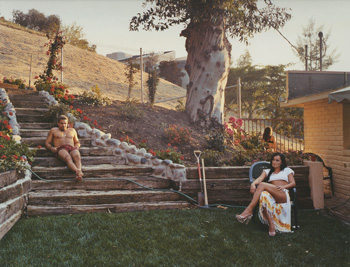The cast and crew of a porn film have gathered in the front yard of a ranch house, a few blocks from where I went to high school in the San Fernando Valley. Women in six-inch heels sink into the lawn; men push around lights and cameras, anxious about losing the light. They are preparing to film a scene in which four blond housewives in a convertible are pursued and overtaken by two men in an appliance-repair van. The neighbors have all come out to water their lawns and witness the scene, and in the late evening light it feels as if Fellini has come to make an updated version of Amarcord.
Throughout the day the event of filming creates a sexualized zone in which the gestures, rituals and scenes of suburban domestic life take on a peculiar weight and density.
The house was rented for the two or three days that it takes to make a porn film. It is common for adult-film companies to shoot on location in tract houses in the heart of the valley—the homes of dentists and attorneys and day traders whose photographs and mementoes can be seen in the backgrounds of these films, and whose decorating tastes give the films their particular “look.” It’s as if the one family went on vacation leaving everything in the house intact, and another family, an odd assembly of very horny adults has temporally taken up residence.
Throughout the day the event of filming creates a sexualized zone in which the gestures, rituals and scenes of suburban domestic life take on a peculiar weight and density. The roll of paper towels on the living room table, the bed linens in a pile by the door, the shoes under the bed all lose their mundane character and are transformed into props or a residue of unseen but very imaginable actions. Even the piece of half eaten pie on the kitchen counter seems suspicious. While the film crew and “talent” are hard at work in the living room I wander through the rest of the house peering into the lives of the people who suddenly left home. I feel like a forensic photographer searching out evidence in a crime scene. But what is the crime?
Lazy afternoons are interrupted not by noisy children but by the uncontrollable desires of delivery boys, baby sitters, coeds and cops. They crowd in the master bedrooms and spill out onto the kitchen floors and onto the patios and into the pools that look just like our neighbors’ pools, like our pool. And by photographing this I’m planted squarely in the terrain of my own ambivalence—that rich and fertile field that stretches out between fascination and repulsion, desire and loss. I’m home again.
—Larry Sultan, from Larry Sultan: The Valley, Scalo, 2004
Larry Sultan was born in New York in 1946. In 1949 his family moved from Brooklyn to Los Angeles. He earned a BA in political science from the University of California at Santa Barbara (1968) and an MFA from the San Francisco Art Institute (1973). He is the recipient of a United States State Department International Arts and Lectures Grant (2000); four National Endowment for the Arts Photography Fellowships (1977, 1980, 1986, 1992) and an Art in Public Places Grant (1976); and a Guggenheim Fellowship (1983). From 1992 to 1996 the traveling exhibition Larry Sultan: Pictures from Home was shown at Bronx Museum of Art, New York; Scottsdale Center for the Arts, Scottsdale, Arizona; The Corcoran Gallery of Art, Washington, DC; Chicago Cultural Center; Museum of Contemporary Art, San Diego; and San Jose Museum of Art, California. His work is part of numerous public collections, including those of the Art Institute of Chicago; Bibliothèque Nationale, Paris; Center for Creative Photography, Tucson, Arizona; The Metropolitan Museum of Art, New York; National Museum of Art, Smithsonian Institution, Washington, DC; and the San Francisco Museum of Modern Art.
